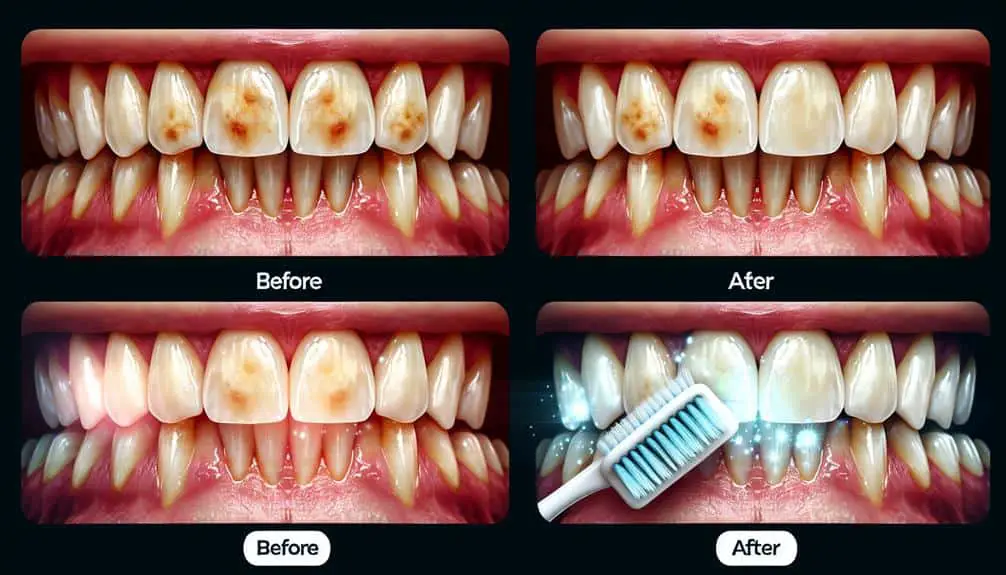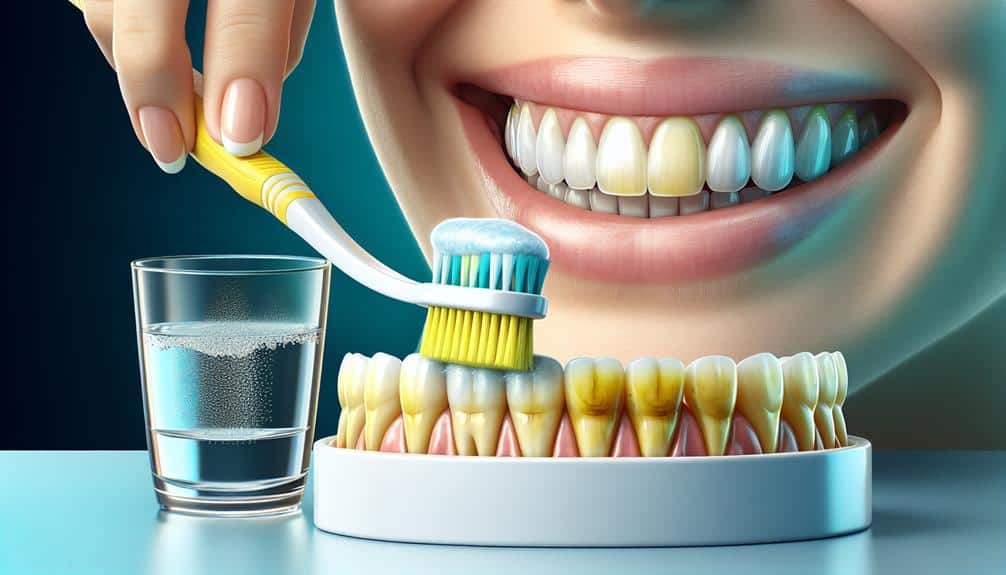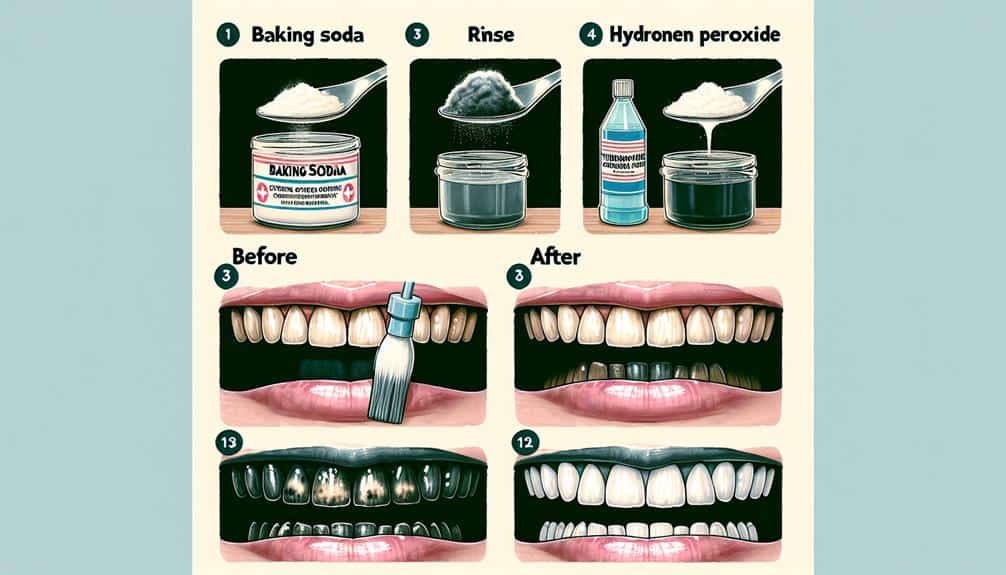To remove tetracycline stains effectively, consider professional whitening treatments by dental experts. These treatments, like high-concentration bleaching gel or dental veneers, can address deep stains. For at-home solutions, try using activated charcoal paste or oil pulling with coconut oil to lift stains. Prevent future stains by maintaining good oral hygiene habits and making dietary changes. Also, follow maintenance tips like regular brushing, flossing, and consuming tooth-friendly foods. Mastering these essential tips will help revitalize your smile and restore your teeth's natural brightness.
Key Points
- Consider professional whitening treatments for deep-seated tetracycline stains.
- Explore at-home remedies like activated charcoal paste for stain removal.
- Maintain good oral hygiene with regular brushing and dental cleanings.
- Limit intake of staining foods and beverages to prevent discoloration.
- Follow maintenance tips like daily flossing for a brighter smile.
Understanding Tetracycline Stains
When considering tetracycline stains, it's important to understand the underlying causes and characteristics of these stubborn discolorations. Tetracycline stains are caused by the incorporation of the antibiotic tetracycline into the structure of developing teeth, leading to a yellow, gray, or brown discoloration. This staining occurs during the period when teeth are forming, often in childhood. The intensity of the stains can vary, with some being mild and others more severe, depending on factors such as dosage, duration of tetracycline exposure, and individual tooth mineralization.
Treatment options for tetracycline stains can be challenging due to their deep-seated nature. Traditional whitening methods like bleaching may not be effective in addressing these stains. More advanced treatments such as bonding, veneers, or crowns are often recommended to mask the discoloration effectively. These options can provide long-lasting results, but it's essential to consult with a dental professional to determine the most suitable treatment plan based on the severity of the stains and individual needs.
Professional Whitening Options
Consider professional whitening options offered by dental professionals to effectively address tetracycline stains that traditional methods may struggle to eliminate. Cosmetic dentistry provides various advanced whitening treatments tailored to tackle stubborn discoloration caused by tetracycline. One popular method is in-office teeth whitening, where a high-concentration bleaching gel is applied to the teeth and activated by a special light to break down the tetracycline stains. This procedure is quick, safe, and delivers noticeable results in a single session.
For more severe tetracycline stains that don't respond well to traditional whitening methods, dental veneers can be a transformative solution. Veneers are custom-made thin shells placed over the front surface of the teeth to mask imperfections, including tetracycline stains, providing a long-lasting and natural-looking result. Your dentist will assess your specific case and recommend the most suitable professional whitening option to help you achieve a brighter, stain-free smile.
Trust the expertise of cosmetic dentistry professionals to enhance the appearance of your teeth and boost your confidence.
At-Home Remedies for Stain Removal
Explore effective at-home remedies for removing tetracycline stains from your teeth to enhance your smile in the comfort of your own home.
When dealing with tetracycline stains, DIY solutions and natural remedies can be beneficial. One popular method is using baking soda as a mild abrasive to gently scrub away surface stains. Create a paste by mixing baking soda with a small amount of hydrogen peroxide and brush your teeth with this mixture a few times a week.
Another natural remedy involves using activated charcoal, known for its absorbing properties, to help lift stains from the teeth. You can make a paste with activated charcoal and water and brush your teeth with it for a few minutes before rinsing thoroughly.
Additionally, oil pulling with coconut oil is believed to promote oral health and help reduce stains. Swish a spoonful of coconut oil in your mouth for about 15-20 minutes daily.
Preventing Tetracycline Stains
To prevent tetracycline stains on your teeth, maintaining good oral hygiene practices is essential. Brush your teeth at least twice a day with a fluoride toothpaste and floss daily to remove plaque buildup, which can contribute to stain formation.
Regular visits to your dentist for professional cleanings are also vital in preventing tetracycline stains. In addition to oral hygiene, consider making dietary changes to reduce the risk of developing these stubborn stains. Limit your intake of foods and beverages that are known to cause staining, such as coffee, tea, red wine, and dark berries.
Drinking water after consuming these items can help reduce their staining effects on your teeth. Moreover, incorporating crunchy fruits and vegetables into your diet can help scrub away surface stains. By combining proper oral hygiene practices with mindful dietary choices, you can significantly lessen the likelihood of developing tetracycline stains on your teeth.
Maintenance Tips for Brighter Smile
For a brighter smile, prioritize consistent oral care routines that include daily brushing and flossing to maintain peak dental hygiene. Ensuring you follow proper maintenance tips can help keep your teeth looking their best. Here are some expert recommendations to enhance your smile:
- Regular Brushing: Brush your teeth at least twice a day with fluoride toothpaste to remove plaque buildup and prevent staining.
- Floss Daily: Make flossing a daily habit to clean between your teeth and along the gumline where your toothbrush may not reach effectively.
- Healthy Diet: Incorporate tooth-friendly foods like crunchy fruits and vegetables that can help clean teeth naturally.
- Limit Staining Foods: Reduce consumption of coffee, tea, red wine, and other foods known to cause tooth discoloration.
Frequently Asked Questions
Are There Any Specific Foods or Beverages That Should Be Avoided to Prevent Tetracycline Stains From Worsening?
To prevent tetracycline stains from worsening, avoid foods and drinks that are highly pigmented like coffee, tea, red wine, and colorful berries. Opt for lighter options and maintain good oral hygiene for effective stain prevention.
Can Tetracycline Stains Be Completely Removed With Just At-Home Remedies, or Is Professional Whitening Necessary?
You might think at-home remedies can work miracles, but for tough tetracycline stains, professional consultation is key. DIY methods are helpful, but to completely remove those stubborn stains, trust the expertise of professional whitening.
Are There Any Specific Toothpastes or Mouthwashes That Are Recommended for Maintaining a Brighter Smile After Tetracycline Stain Removal?
To maintain a brighter smile after tetracycline stain removal, consider using whitening toothpaste and mouthwash. These products can help upkeep your teeth's brightness. In cases where stains persist, cosmetic dentistry options like veneers may be recommended for a lasting solution.
How Long Does It Typically Take to See Noticeable Results From At-Home Remedies for Tetracycline Stain Removal?
For tetracycline stain removal, noticeable results from at-home remedies vary. Effectiveness hinges on consistency. Some see changes in weeks, while others may take months. Alternative treatments, like professional whitening, can expedite results. Dietary restrictions complement efforts.
Are There Any Alternative Treatments or Procedures Available for Tetracycline Stains if Professional Whitening Options Are Not Feasible?
If professional whitening isn't an option, consider natural remedies or microabrasion techniques in cosmetic dentistry. Laser treatment may also help with tetracycline stains. Consult a dentist for alternative treatments suitable for you.



